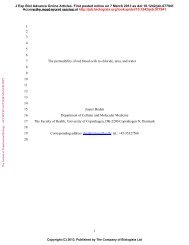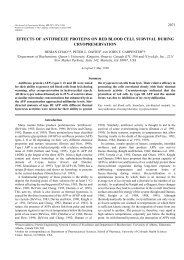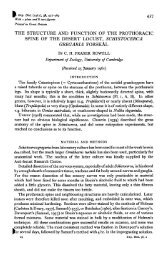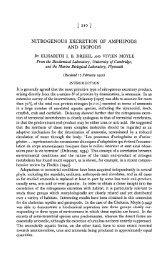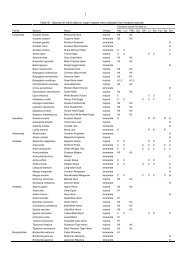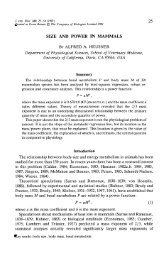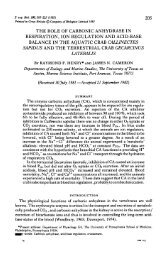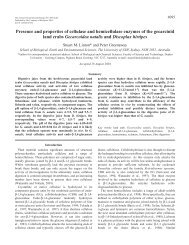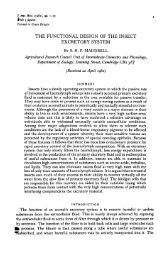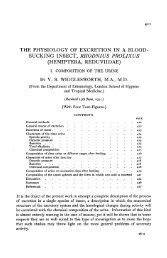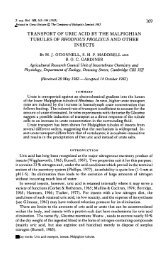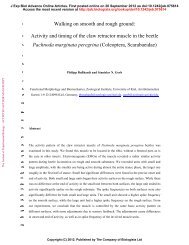the excretory system of the stick insect, dixippus morosus
the excretory system of the stick insect, dixippus morosus
the excretory system of the stick insect, dixippus morosus
You also want an ePaper? Increase the reach of your titles
YUMPU automatically turns print PDFs into web optimized ePapers that Google loves.
The <strong>excretory</strong> <strong>system</strong> <strong>of</strong> <strong>the</strong> <strong>stick</strong> <strong>insect</strong> 191<br />
40-6-5 mm. 3 /hr. The urine rose in <strong>the</strong> cannula as a pale yellow fluid soon becoming<br />
dark brown on exposure to air.<br />
As was already known, <strong>the</strong> potassium concentration is higher and <strong>the</strong> sodium<br />
concentration is lower in <strong>the</strong> urine than in <strong>the</strong> haemolymph. Calcium, magnesium<br />
and chloride are lower in <strong>the</strong> urine, but phosphate is higher. There is an apparent<br />
anion deficit <strong>of</strong> some 50 m.equiv./l. Uric acid is in higher concentration in <strong>the</strong><br />
urine as might be expected.<br />
CHANGES IN THE URINE DURING ITS PASSAGE<br />
THROUGH INTESTINE AND RECTUM<br />
In this and in <strong>the</strong> next section consideration is restricted to water, sodium and<br />
potassium. Methods <strong>of</strong> analysis suitable for <strong>the</strong> small volumes available have not<br />
yet been developed for o<strong>the</strong>r constituents <strong>of</strong> <strong>the</strong> urine.<br />
It is immediately obvious that with urine being produced at a rate <strong>of</strong> about<br />
6 mm. 3 /hr. all <strong>the</strong> water would be removed from <strong>the</strong> haemolymph in less than<br />
24 hr. if it were not reabsorbed in <strong>the</strong> hindgut. It is also obvious that all <strong>the</strong><br />
potassium in <strong>the</strong> haemolymph would be removed in less than 3 hr. and <strong>the</strong>refore<br />
potassium, like water, must presumably be reabsorbed. To demonstrate such<br />
reabsorption is not altoge<strong>the</strong>r a straightforward problem since besides <strong>the</strong> urine<br />
semi-digested food containing potassium is being passed into <strong>the</strong> hindgut at an<br />
unknown rate. This complication can be avoided by using fasting <strong>insect</strong>s.<br />
For <strong>the</strong>se experiments <strong>the</strong> <strong>insect</strong>s were kept without food in glass jars lined with<br />
moist filter-paper, in which <strong>the</strong>y could survive for more than 10 days. The production<br />
<strong>of</strong> faeces fell <strong>of</strong>f rapidly from about 20 mg. to about 2 mg. dry weight per<br />
<strong>insect</strong> per day. 20 mg. <strong>of</strong> 'fasting' faeces were ashed and found to contain 0-3 ^equiv.<br />
<strong>of</strong> sodium and i8^equiv. <strong>of</strong> potassium; this indicates a loss <strong>of</strong> c-03/xequiv. <strong>of</strong><br />
sodium and i-8/xequiv. <strong>of</strong> potassium per <strong>insect</strong> per day. From figures already<br />
quoted it can be calculated that <strong>the</strong> Malpighian tubules will excrete c-7/xequiv. <strong>of</strong><br />
sodium and 2i^equiv. <strong>of</strong> potassium in one day, so that considerable reabsorption<br />
must take place.<br />
This <strong>of</strong> course presupposes that <strong>the</strong> rate <strong>of</strong> flow and composition <strong>of</strong> <strong>the</strong> urine<br />
are maintained at <strong>the</strong> same levels in <strong>the</strong> fasting <strong>insect</strong>. The conspicuous accumulation<br />
<strong>of</strong> granules in <strong>the</strong> Malpighian tubules <strong>of</strong> <strong>the</strong> fasting <strong>insect</strong> suggest at first<br />
sight that <strong>the</strong> flow <strong>of</strong> urine must be reduced almost to zero, but in fact this is not so.<br />
Collections <strong>of</strong> urine made in parallel experiments on fed and fasting <strong>insect</strong>s showed<br />
only a small decline in rate <strong>of</strong> flow, <strong>the</strong> figures being 5-4 and 6-4 mm. 8 /hr. for fed<br />
<strong>insect</strong>s and 4-2 and 2-9 mm. s /hr. for fasting <strong>insect</strong>s.<br />
Sodium and potassium concentrations in <strong>the</strong> urine <strong>of</strong> fasting <strong>insect</strong>s are given<br />
in Table 3, col. 3, and when <strong>the</strong>se are compared with <strong>the</strong> figures in Table 2, col. 3,<br />
it can be seen that <strong>the</strong> sodium concentration is slightly greater and <strong>the</strong> potassium<br />
concentration is slightly less in 'fasting' urine as compared with 'fed' urine.<br />
Taking rate <strong>of</strong> flow as 3-5 mm. 3 /hr., sodium concentration as 6-5 m.equiv./l. and<br />
potassium concentration as 125 m.equiv./l. <strong>the</strong> quantities excreted by <strong>the</strong> Malpighian<br />
tubules <strong>of</strong> a fasting <strong>insect</strong> per day are 0-54 ^.equiv. <strong>of</strong> sodium and 10-5 /xequiv.




